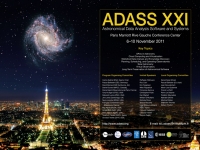Daniel Michalik (Lund Observatory, Lund University), Lennart Lindegren (Lund Observatory, Lund University), David Hobbs (Lund Observatory, Lund University), Uwe Lammers (European Space Agency), Yoshiyuki Yamada (Kyoto University)
Abstract
The Hipparcos mission (1989-1993) resulted in the first space-based
stellar catalogue including measurements of positions, parallaxes and
annual proper motions accurate to about one milli-arcsecond. Two space
astrometry missions will follow in the near future: The ultra-small
Japanese mission Nano-JASMINE is expected to be launched early 2012 for
its nominal mission duration of two years. It will determine positions
and annual proper motions with an accuracy comparable to Hipparcos. In
mid 2013 the next-generation ESA mission Gaia will deliver some tens of
micro-arcseconds accurate positions, parallaxes and proper motions
during its five years mission. Data from both missions will be reduced
using the Astrometric Global Iterative Solution (AGIS) of the Gaia
mission, developed by teams at ESA/ESAC and Lund Observatory.
Until the final Gaia catalogue is published in early 2020 the best way
of improving proper motion values is the combination of positions from
different missions separated by long time intervals. Rather than
comparing positions from separately reduced catalogues, we have
developed a method to combine the information from the different data
sets in a statistically optimal way by making a joint astrometric
solution. This allows to obtain good results also where each data set
alone is insufficient for an accurate reduction. As a demonstration of
the method we have extended AGIS to incorporate prior information from
the Hipparcos catalogue in the least squares solution of the astrometric
parameters when reducing the Nano-JASMINE data. We present preliminary
results of simulations showing a very significant improvement of the
proper motion values.
The goodness-of-fit of the combined solution is sensitive to small
deviations of the stellar motions from the assumed (rectilinear) model.
We are investigating how this can be used to identify binary candidates
with orbital periods of decades to centuries. This will contribute to
the census of the binary population within a few hundred parsecs from
the sun by filling a difficult-to-observe gap between the shorter period
spectroscopic binaries and the longer period visually resolved systems.Poster in PDF format
Paper ID: P100
Poster Instructions
|

